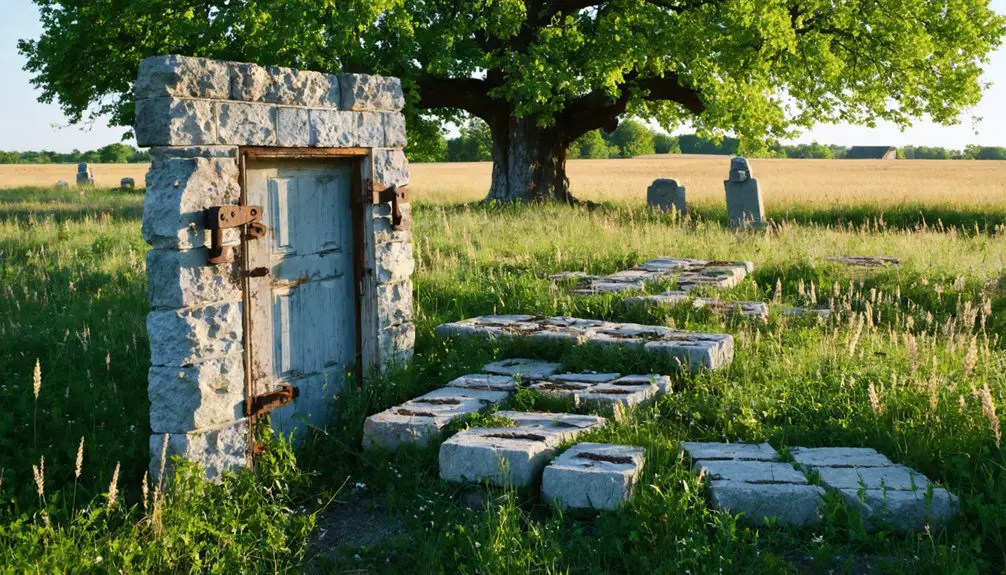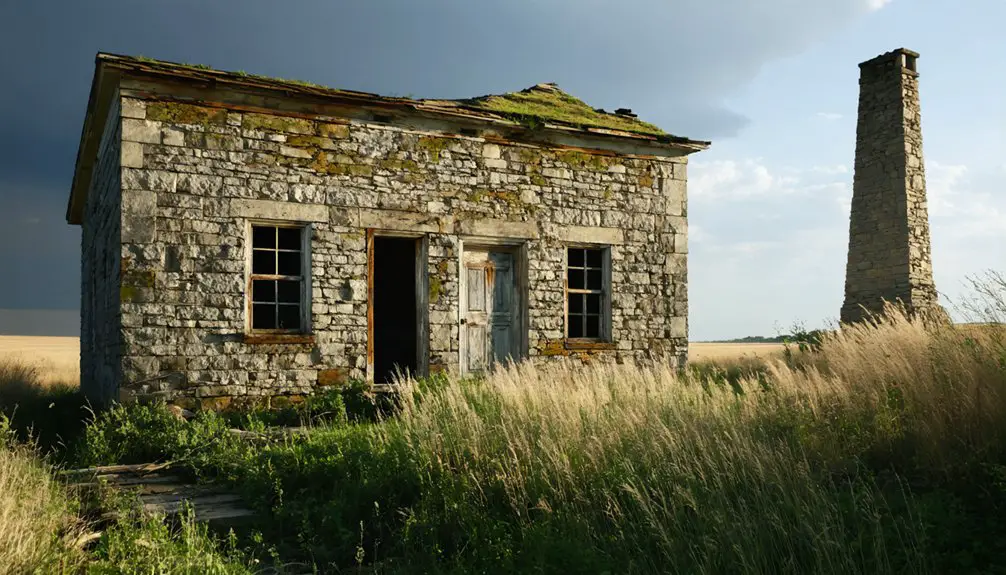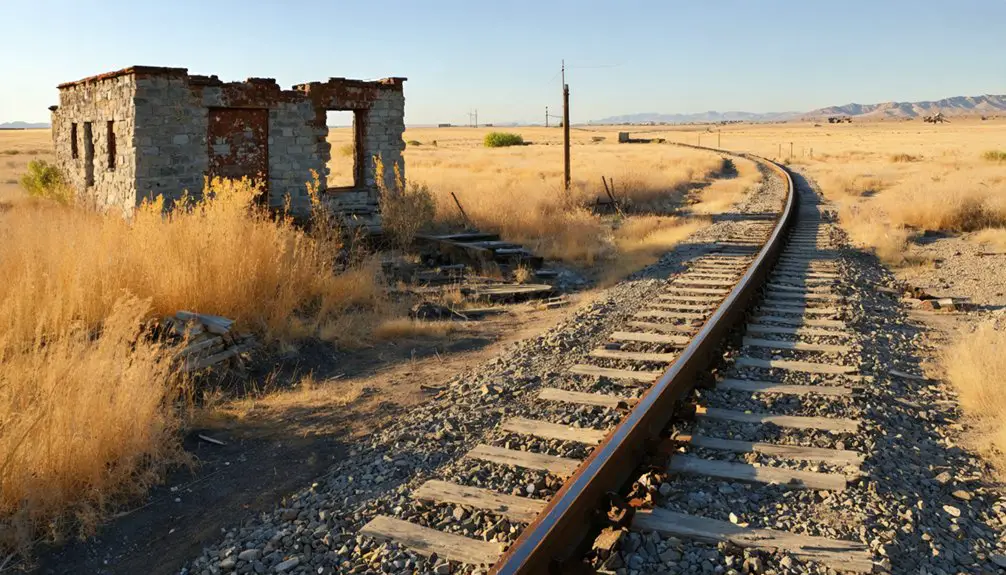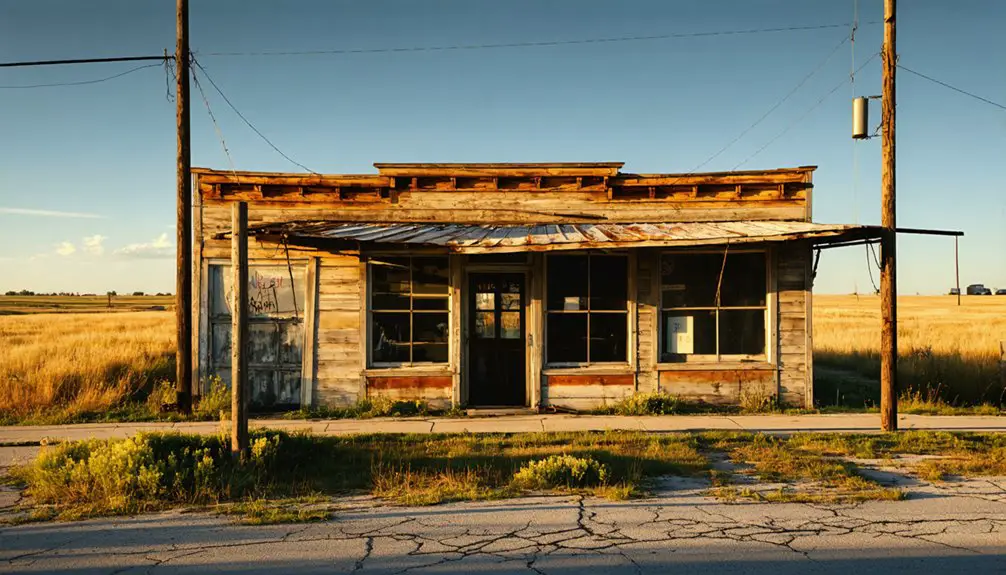You’ll find Big Springs, Kansas along the historic Oregon Trail, where it served as a vital waypoint starting in 1854. The town played a significant role in anti-slavery efforts, hosting the founding of the Free-State Party in 1855. Though it thrived initially with churches, shops, and a post office, the settlement declined after being bypassed by the Santa Fe Railroad in the 1890s. Today’s ghost town status holds fascinating stories of frontier life and Kansas’s path to statehood.
Key Takeaways
- Big Springs, Kansas became a ghost town after being bypassed by the Santa Fe railroad in the 1890s, reducing its population to 40 residents.
- Founded in 1854, the town was a vital Oregon Trail waypoint and hosted the historic Big Springs Convention opposing slavery in 1855.
- The town’s namesake spring was destroyed during Kansas Turnpike construction, further diminishing its historical significance and appeal.
- Historic structures include an 1856 United Brethren Church (now Methodist) and an abandoned 1878 red brick schoolhouse.
- Located in Douglas County, Big Springs maintains its ghost town status while preserving its role in Kansas’s Free-State movement history.
The Oregon Trail Connection
As emigrants pushed westward along the Oregon Trail in the mid-1800s, Big Springs emerged as an essential waypoint along the 15-mile segment between the Wakarusa River and the western edge of Douglas County, Kansas.
After crossing the Wakarusa, you’d travel eight miles westward, following a ridge that divided the Kansas and Wakarusa watersheds over Mount Oread before reaching this crucial stop. Similar to daily travel distances, emigrants would typically cover 10-15 miles before making camp.
For Trail Navigation, Big Springs served as one of three significant water sources in eastern Kansas, making it a natural camping and resting site.
You’d find multiple routes converging here, connecting Missouri River starting points like Independence, Westport, and Weston. The Platte River Valley became a critical convergence point for these various trail segments as travelers continued westward.
The General Land Office’s formal surveying helped establish this portion of the trail, while reliable water sources influenced route selections and settlement patterns throughout the region.
Early Settlement and Township Formation
While pioneers frequented Big Springs as a popular Oregon Trail watering hole, the site’s importance grew beyond a simple rest stop when it became Douglas County’s first official township in 1854.
From frontier watering hole to Douglas County’s pioneering township, Big Springs transformed from trail stop to settled community.
The settlement’s early governance centered around providing essential services to both travelers and permanent residents. You’ll find that by 1883, the community had established strong foundations with about 40 residents, two stores, a post office, and various trade shops. The area became a hub for the Free-State movement when it hosted the historic Big Springs Convention in 1855. Similar to Columbia’s history, the uncertainty of land claims persisted until official surveys were completed.
The United Brethren Church, built in 1856, became a cornerstone of community cohesion, remaining active today as a Methodist church.
Despite its historical significance as the county’s oldest township, Big Springs never developed into an incorporated municipality, instead maintaining its character as a rural settlement with deep ties to Kansas’s territorial period.
Free-State Party Origins

You’ll find Big Springs’ most significant historical moment on September 5, 1855, when about 100 delegates gathered along the California Road to establish the Free-State Party in opposition to pro-slavery forces.
The site became a vital meeting point for anti-slavery leaders like Charles Robinson and James Lane, who drafted the party’s founding platform and organized resistance against the territorial “bogus legislature.” Their movement successfully blocked pro-slavery efforts through support from Republicans in Congress. The meeting addressed serious concerns about election fraud that had occurred during the March 1855 territorial legislature vote.
The town’s strategic location along the Underground Railroad network strengthened its role as an anti-slavery stronghold, where Free-State supporters coordinated their efforts to prevent Kansas from becoming a slave state.
Historic Convention Location
During the tumultuous summer of 1855, Big Springs became the epicenter of Kansas Territory’s anti-slavery movement when it hosted the historic Free-State Convention on September 5-6.
Following preliminary meetings in Lawrence, you’ll find the site where approximately 100 delegates gathered to forge anti-slavery unity and establish the Kansas Free-State Party.
The convention’s significance extended beyond its immediate location in Douglas County.
Here, influential leaders like James Lane and Charles Robinson worked to harmonize diverse free-state factions.
You can trace the path where delegates nominated Andrew H. Reeder for Congress and formed committees to present their proceedings to Governor Shannon.
The site’s historical importance grew as it witnessed the birth of a shadow government that would later establish itself in Topeka.
The convention attracted 131 total votes from delegates instructed to focus on prohibiting slavery in Kansas Territory.
Under Colonel Lane’s leadership, the convention produced key resolutions advocating resistance against non-resident voters and establishing Kansas as a free state.
Underground Railroad Connections
The Big Springs Free-State Convention sparked a wave of organized anti-slavery activism that extended far beyond political meetings.
Quaker involvement became essential near Big Springs, as settlers from Iowa communities like Springdale established Underground Railroad stops and safe houses throughout the region by 1860. You’ll find that these freedom networks connected to larger routes through Iowa and Nebraska, avoiding dangerous proslavery checkpoints along the Missouri River. The network relied on conductors and keepers to coordinate the movement of escapees to freedom.
The area’s fugitive routes linked to General Lane’s protected “Lane Trail” and extended through Illinois, Indiana, and Ohio into Canada. Secrecy was crucial for the success of these covert operations.
Free-state advocates maintained strict secrecy, using coded messages and trusted local collaborators to guide escaped slaves. The success of these operations depended on vigilance committees, sympathetic residents, and the unwavering commitment of free-state settlers to resist slavery’s expansion into Kansas Territory.
Anti-Slavery Movement Leadership
When settlers gathered at Big Springs in September 1855, they formally established the Free-State Party as a direct response to the fraudulent pro-slavery territorial legislature.
The movement’s leadership dynamics centered around two prominent figures: Dr. Charles Robinson, representing New England emigrants, and James H. Lane, a former Democrat from Indiana who led Midwestern settlers.
While both leaders shared the goal of preventing Kansas from becoming a slave state, they differed in their strategies. Robinson focused on political alliances with national Republicans, while Lane advocated for more direct resistance.
The party’s leadership worked to form a shadow government based in Topeka, rejecting the territorial government’s slave codes.
Historical Buildings and Architecture

You’ll find the native stone buildings of Big Springs reflect common 19th-century Kansas construction methods, with several structures still standing in various states of preservation today.
The United Brethren Church, built in 1856, has evolved from its original design while maintaining continuous use as a Methodist church, demonstrating the adaptability of early frontier architecture.
The red brick schoolhouse, though now abandoned, reveals the progression of deterioration typical in ghost town structures, with exposure to harsh Kansas weather taking its toll on the late 19th-century craftsmanship.
Stone Building Construction Methods
Stone construction methods in Big Springs evolved from both ancient dry-stone techniques and mortared masonry traditions, reflecting the available materials and architectural knowledge of early Kansas settlers.
You’ll find that local builders combined practical dry-stone techniques for foundation work with basic lime mortar applications learned from European traditions. They’d stack locally quarried limestone blocks using minimal mortar, similar to classical architecture methods but adapted for frontier conditions.
While Gothic innovations weren’t prominent in Big Springs’ utilitarian structures, you can spot regional practices in the way settlers positioned stones to handle Kansas’ extreme weather.
The buildings’ construction showed a practical blend of old-world knowledge and pioneer ingenuity, with stones carefully fitted to withstand both harsh winters and summer storms.
Church’s Architectural Evolution
The architectural journey of Big Springs’ church began in 1855 with Rev. W.A. Cardwell leading the construction of a modest stone building.
You’ll find this initial structure embodied true frontier church symbolism – no stained glass or decorative elements, just pure pioneering spirit in its austere design.
After nature’s challenges, including wind damage and a devastating fire in 1892, the church’s architectural resilience shone through.
In 1898, the community dismantled an abandoned church from Whiting and transported it to Big Springs, rebuilding across from the original site.
This adaptive reuse demonstrated the settlers’ resourcefulness. The reconstructed church maintained its practical, unembellished style, using local materials and simple construction methods.
Today, the original 1856 stone structure still stands as an active Methodist church, a monument to frontier ingenuity.
Schoolhouse Deterioration Patterns
While Big Springs’ wooden schoolhouse stood proudly in 1878, its vulnerability to environmental forces marked the beginning of a complex deterioration pattern seen across Kansas ghost town schools.
Even after upgrading to brick and stone construction in 1926, you’d find the schoolhouse battling Kansas’ harsh climate. Freeze-thaw cycles attacked mortar joints, while heavy rains seeped into basements, weakening foundations.
The building’s architectural decay accelerated through specific points: broken window panes allowed moisture to rot wooden frames, enclosed stairways trapped damaging humidity, and load-bearing modifications disrupted structural integrity.
You’ll notice how schoolhouse materials suffered further from nature’s assault – termites invaded wooden elements, roots destabilized foundations, and bird nests in eaves introduced destructive organic acids, all hastening the building’s decline.
Transportation’s Impact on Growth

Despite its early prominence as a watering stop along the Oregon and California Trails, Big Springs’ growth trajectory suffered dramatically from its inability to secure railroad access in the late 1800s.
The absence of rail access crushed Big Springs’ dreams of growth, despite its strategic location on pioneer migration routes.
When the Santa Fe railroad bypassed the town in the 1890s, choosing a route closer to the Kansas River, it sealed Big Springs’ fate. The shift in transportation routes triggered a devastating economic decline that the town never recovered from.
Key factors that shaped Big Springs’ diminishment:
- By 1883, the town had only 40 residents and minimal businesses while railroad towns flourished.
- The rise of automobiles after 1915 further isolated the community from major traffic.
- Construction of the Kansas Turnpike destroyed the town’s namesake spring, erasing a historic landmark.
Today, Big Springs remains a semi-ghost town, maintaining roughly the same population it had in 1883.
Daily Life in Early Big Springs
In Big Springs’ earliest days of 1854, settlers William Harper and John Chamberlain established a tight-knit community that centered around three essential institutions: churches, stores, and trade shops.
You’d find daily life revolving around the United Brethren Church, which served as more than just a place of worship – it was the heart of community gatherings and social connections.
While working the land dominated most settlers’ days, you could visit one of two local stores for supplies, or take your wagon to the blacksmith for repairs.
The small but bustling township supported about 40 residents by the 1880s, with agricultural practices sustaining both locals and travelers along the nearby Oregon Trail.
The post office, hotels, and cabins kept you connected to the outside world until 1903.
The Path to Ghost Town Status

Although Big Springs initially showed promise as a strategic Oregon Trail stop and political meeting point in the 1850s, the town’s trajectory toward ghost status began with its failure to secure a railroad connection.
Economic factors and shifting community dynamics sealed the town’s fate, as nearby cities with better infrastructure drew away commerce and population.
Key developments that accelerated Big Springs’ decline:
- The permanent closure of the post office in 1903, forcing residents to rely on neighboring towns
- A stagnant population of just 40 people, with minimal local businesses throughout the late 1800s
- The absence of industry or large-scale agriculture to sustain growth
You’ll find that by 1910, Big Springs had transformed from a hopeful frontier settlement into a diminished rural community, though some historic buildings still stand as evidence of its earlier significance.
Present-Day Community Life
While Big Springs retains its ghost town classification, you’ll find a small but stable community of around 40 residents who’ve made this historic settlement their home. Most residents commute to Topeka or Lawrence for work, using Big Springs as a peaceful bedroom community.
Community activities center around the historic 1856 Methodist church, which continues to serve as a gathering place, and the active fire station that provides essential emergency services.
You’ll notice varying states of preservation among the native stone buildings and houses – some carefully restored, others slowly decaying. Though there’s no post office or local school anymore, resident interactions persist through shared services and institutions.
Children attend Shawnee Heights schools in nearby Tecumseh, while the community maintains its rural character without commercial development.
Legacy in Kansas History
The legacy of Big Springs runs deep in Kansas history as the oldest settlement in Douglas County, established in 1854.
Big Springs established itself as Douglas County’s pioneer settlement in 1854, marking the beginning of an enduring Kansas legacy.
You’ll find its cultural identity woven into the fabric of Kansas’s territorial struggles, particularly through its pivotal role in hosting the first Free-State convention of 1855.
While the town’s influence waned as neighboring communities grew, its historical significance endures through preservation efforts of key structures.
- The 1856 United Brethren Church continues serving the community as a Methodist church
- Native stone buildings and the red brick schoolhouse stand as symbols to frontier architecture
- Its role in the anti-slavery movement during Bleeding Kansas remains a cornerstone of state history
Today, Big Springs serves as a powerful reminder of how transportation and economic shifts can transform a once-vital settlement into a historic ghost town.
Frequently Asked Questions
What Native American Tribes Originally Inhabited the Big Springs Area?
You’ll find the area’s tribal heritage centered on the Kansa (Kaw) people, who shared these ancestral lands with Osage and Pawnee tribes, each leaving their cultural significance along the Kansas River valley.
How Did Residents Get Their Water Supply in Early Big Springs?
You’d find early residents primarily relied on the natural spring for their water needs, while some supplemented with personal wells and cisterns as part of the town’s basic water infrastructure.
Were There Any Notable Crimes or Lawlessness During Big Springs’ Peak?
Peculiarly peaceful, you won’t find significant law enforcement issues or crime statistics from Big Springs’ peak period. Historical records show no notable criminal activity during the town’s bustling days in the 1850s-1880s.
What Was the Average Property Value in Big Springs During 1880S?
You’ll find property appraisal records from the 1880s show land values ranging from $2 to $10 per acre, varying by economic conditions, improvements, and proximity to water or transportation routes.
Did Any Famous Pioneers or Historical Figures Visit Big Springs?
Like footprints in the sand, famous visitors and pioneer stories from Big Springs remain elusive. You’ll find Free-State convention delegates visited in 1855, but there’s no record of specific renowned figures.
References
- https://legendsofkansas.com/big-springs-kansas/
- https://www.youtube.com/watch?v=Pf5n1PX1g3M
- https://civilwaronthewesternborder.org/map/big-springs-kansas
- https://legendsofkansas.com/kansas-ghost-town-list/
- https://hcsghosttowns.wordpress.com/2021/08/21/big-springs-kansas/
- https://khri.kansasgis.org/photos_docs/045-5673_5.pdf
- https://en.wikipedia.org/wiki/Oregon_Trail
- https://octa-trails.org/articles/where-did-the-oregon-trail-go/
- https://en.wikipedia.org/wiki/Route_of_the_Oregon_Trail
- https://fhwaapps.fhwa.dot.gov/bywaysp/byway/2466



